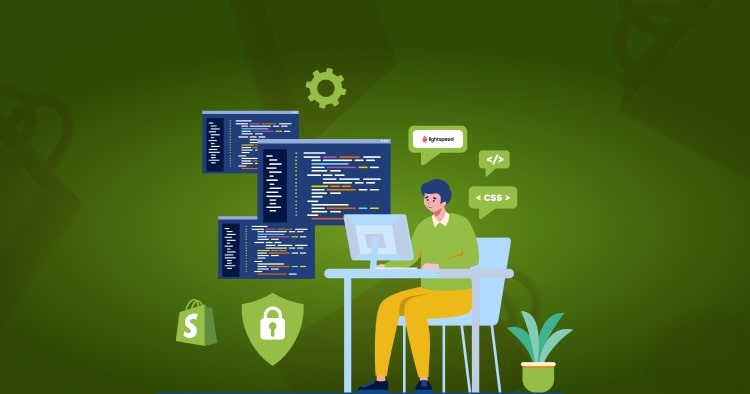What is a TRUST BADGES SHOPIFY?
With an increase in the rate of online shopping orders, it has been noted that cybersecurity crime rates have also increased simultaneously. Due to an increase in incidents related to cybersecurity, online businesses need to provide their customers with added security that they must show their website to gain the confidence of their potential customers. One such way of winning the trust of customers is to use trust badges. To be a part of this rate race, Shopify has also joined on the bandwagon and added Shopify trust badges.
Shopify trust badges are small icons, logos, or images that are placed on the Shopify store to help gain the trust of potential customers. Mostly, they are seen on checkout pages to help reassure potential customers that it is completely safe to share their personal details with Shopify. It is seen as a pictorial depiction of Shopify’s security features that a customer can trust upon.
The Importance of a Shopify Trust Badge for Conversion Rate Optimization in E-commerce
In recent times, it has been studied that the main cause of abandoned carts is a lack of trust in the security features offered by the website. For this reason, customers abandon their carts, not wanting to risk their confidential details at the hands of hackers. Cybersecurity has always been the main concern for customers who want to shop online.
To combat this issue, Shopify made available the trust badges option, for its stores, to help reduce shopping cart abandonment cases and increase sales. Almost all of the Shopify stores have this feature added. If your store does not have this feature, then it might increase the cart abandonment changes by the customer, as they might view them as red flags. You must place the badges in such a way that they are self-explanatory and are visible to the customers. Most store owners prefer adding trust badges to their checkout page. However, you can even add them to your storefront and product pages, if positioned correctly.
This brings us to the next question: how to add trust badges to Shopify?
How to add Trust Badges to Shopify?
As mentioned above, Shopify trust badges can be added to your product pages, checkout page, and even on the footers of your home page. This is where the Shopify badges are usually placed. Adding trust badges to Shopify can be done on your own involving different methods, or with the help of apps.
-
Using Special Apps
Shopify has an app store that offers a countless number of apps, both free and paid, for assisting you to add trust badges to your Shopify store. It is noted that the free apps provide the user with basic badges for their page, whereas the paid apps offer more options for trust badges.
-
Adding Images
If you do not wish to use any app, you can add trust badges to your developed Shopify store in the form of images. Trust badges are best used in the SVG file format. For the badges you want to add, you can do it manually just like you would add any other image. The benefit of using the SVG file format is that it loads quickly and does not get pixelated.
-
Editing the Code of your Store
Before you do this, it is highly recommended that you create a backup for your theme. You can add trust badges to your Shopify store by editing your store’s theme. It is a lengthy process but it helps you to save up on some bucks.
Types of Shopify Trust Badges
There are five main types of trust badges that one can use on their Shopify store to help increase the conversion rate.
The 5 types of trust badges for Shopify are:
-
Safe Checkout Badges
This is the most important type of trust badge for your design Shopify store. This helps to win the trust of the customer by showing them the Secure Socket Layer (SSL) certificate, which is important to inform the customer that the details required for any purchase would be protected from any theft.
-
Accepted Payment Badges
Displaying the badges of the accepted payment companies could prove to be a sigh of relief for your customers. These badges include PayPal, Visa, MasterCard, etc.
-
Money-Back Guarantee Badges
This badge helps to comfort the customer and helps in removing any fear involved in online shopping that they may have. This helps in taking the trust level of your potential customer to a higher level.
-
Free Shipping and Returns Badge
This sets up a feeling of security and trust within your customer, preventing them from hosing any second thoughts from ordering from your store.
-
Third-Party Endorsements
Third-party endorsement badges are like the cherry on top. These websites, such as Google, do not endorse other websites until and unless they run a background check.
Trust badges for Shopify help all the special features to be noticed by the customer right away. This helps the customer to sense a secure environment even before they are done with purchasing online from your store. Trust badges can have a great psychological impact on your customers.
Security Features
Every store has different security features- some have basic features and some have advanced features. Since store owners spend so much to enhance the security of their stores, it is generally a good idea to display these features. The best way to display them is in the form of badges. The basic form of security offered is the SSL certificate which is mostly displayed by all stores. Some stores also use anti-malware and anti-virus software that can be displayed on the stores in the form of badges.
Read Also: Shopify SSL Certificate
Payment Methods
Displaying the payment method options in the form of trust badges helps to make the customer more comfortable during their checkout process. Adding your shipping partners too would be a great idea.
Ecommerce Partners
Showing e-commerce partners in the form of badges can also be a good way to help gain the trust and approval of your customers. Third-party endorsements are generally seen as one of the best ways to help gain the approval of customers.
Store Policies
Store policies, such as free shipping and returns, money-back guarantee, must always be displayed in the form of badges on your storefront.
Shopify Trust Badges- Summary
Trust badges may be an insignificant thing, but they have a greater impact on customers. It is a fact that people get more attracted to pictures as compared to text. Trust badges help to catch the attention of your potential customer and help to convey the message right away. Adding trust badges can help to significantly reduce the cases of cart abandonment by customers.
—How do the Shopify Trust Badges work?
Shopify trust badges can be downloaded with the help of an app from the Shopify app store, by adding images manually, or by editing your store’s code. Once these badges are added to your Shopify store, you can rely on them for delivering the right message to your potential customers.
—How do I add a secure checkout to Shopify?
Open the checkout page and edit it to add a secure checkout image, or directly add trust badges through an app from Shopify’s app store.
—How do I make Shopify secure?
Since cybersecurity has always been a big issue with customers, you must spend extra time and effort on working on the security of your store. The SSL certification is a very basic security measure. You must have anti-malware, anti-virus software supported on your checkout page to prevent any cybersecurity issues from happening. All the security features you offer should be displayed in the form of trust badges on your store.
—How do I add trust badges to Shopify Footer?
Whatever position you choose, you can easily add trust badges there, including the Shopify footer. The position of the trust badges is in your hands, whether you do it manually, or through an app.
What is Shopify app development?
Shopify app development refers to the process of creating a custom app for a specific client or general public. Shopify allows developers to develop various kinds of apps to improve the ecommerce store’s functionalities and features. The Shopify app development can be carried out by using Shopify APIs and can either be developed for individual clients or Shopify App Store purchases.






